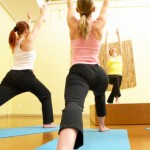
Two of the most popular styles of Yoga classes are Ashtanga and Vinyasa. The defining characteristic of Vinyasa is the alignment of movement and breath; and, technically, Ashtanga might be considered the mother of today’s many Vinyasa styles, but the history of these two styles is a much deeper subject. In modern times, both styles seem to stem from the Krishnamacharya Yoga lineage, and both highlight breath-centered movement. On the other hand, the Yoga Korunta is connected to the origin of Ashtanga, while the Sun Salutations seem to be the beginning of Vinyasa flow.
The biggest difference between Ashtanga and Vinyasa lies in the sequencing. Ashtanga Yoga originally consisted of four series of postures: primary, secondary, advanced A and advanced B. Today there are six series of postures. The series are sequential in that a practitioner must master one before he or she can move on to the next. Each series consists of a predefined order of postures (asanas) that students practice the same way, every time. On the other side of the coin, Vinyasa class sequences vary in sequencing, and the practitioner might experience an entirely different sequence each time he or she practices.
Each Ashtanga series revolves around a category of asanas: the primary series centers on forward bends, the secondary series focuses on back bends, and the advanced series emphasizes arm-support and arm-balancing poses. As the class progresses, the postures in the series, become more complex. Vinyasa Yoga sequences, on the other hand, often feature a peak pose. The peak pose is a challenging and complex pose that the teacher has selected for a particular practice. The teacher leads the class through a sequence of postures that helps students prepare for practice and recover from the peak pose.
Both Ashtanga and Vinyasa employ pose transitions or flows. In the Ashtanga practice, the student performs an asymmetrical pose on the right side, moves through a sequence, and then repeats the pose on the left side. In Vinyasa Yoga, a student may link several asymmetrical poses together before finishing and switching to the other leg.
Ashtanga classes can be either teacher-led or “Mysore,” which means self-led. In a Mysore class, each student practices an Ashtanga series from memory, moving at his or her own pace. The teacher walks around and provides individual adjustments and instruction, as needed. In contrast, a Yoga teacher almost always leads a Vinyasa class. The Vinyasa teacher will cue the entire class together and offer some individual adjustments on an as-needed basis.
Finally, students of Ashtanga Yoga usually do not use props, posture modifications, or music. In Vinyasa classes, some teachers make props available, use background music, and encourage their students to modify postures, as needed.
© Copyright – Aura Wellness Center – Publications Division
To see our selection of Online Yoga teacher training courses, please visit the following link.
https://www.aurawellnesscenter.com/store/
or Directly to Our Vinyasa Yoga Teacher Training Course Online:

Thanks for sharing this comparative article between Ashtanga and Vinyasa Yoga.